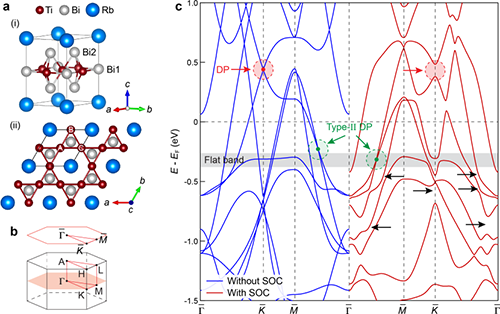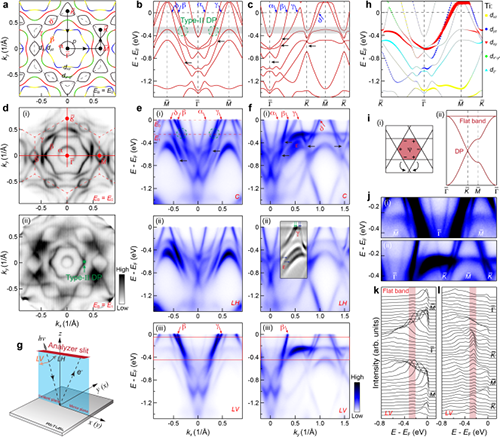Scientists reveal the band topology and orbital-selective nematicity in a new Ti-based kagome superconductor
Date:22-12-2023 Print
The kagome superconductor with a two-dimensional corner-sharing triangular lattice has attracted tremendous attention due to the interplay between nontrivial band topology, anomalous Hall effect (AHE), charge density waves (CDW), pair density wave (PDW), electronic nematicity and unconventional superconductivity. All these exotic quantum phenomena are thought to originate from the unique electronic structure of the kagome lattice including flat bands, Dirac cones and van Hove singularities. The flat band together with the van Hove singularities allows the system to remain in the strongly interacting regime. While, the Dirac cones promote non-trivial topology.
The kagome superconductor thus provides an excellent opportunity to study correlation-driven electronic states. Among them, electronic nematicity, commonly observed in juxtaposition with unconventional superconductivity, generates complicated superconducting pairing and intertwined electronic orders. The understanding the nature of the nematic state and its consequences for the electronic band structure and superconductivity has therefore become a key issue in kagome superconductors as well as high-temperature superconductors.
Nevertheless, in the present studies on kagome superconductor, the definitive identification of unique electronic structures is still scarce and the underlying mechanism to induce those exotic quantum phenomena from such electronic structures remains illusive. Meanwhile, identifying the driving force of electronic nematicity has been a central challenge for understanding nematicity. In iron-based superconductors, the problem is complicated because the spin, orbital and lattice degrees of freedom are intimately coupled. In AV3Sb5 kagome superconductors, the electronic nematicity exhibits an intriguing entanglement with CDW, making understanding its origin difficult. Thus, the discover of new kagome superconductors and explore the origins of CDW, PDW, electronic nematicity, and their correlation with unconventional superconductivity in this kagome system are of great significance.
Recently, a team led by Prof. GAO Hong-jun and Prof. YANG Haitao from Institute of Physics, Chinese Academy of Sciences (CAS), in collaboration with SHI Ming's team from Paul Scherrer Institute, Switzerland, and Prof. WU Xianxin from Institute of Theoretical Physics, CAS, Prof. HU Jiangping and Prof. DONG Xiaoli from Institute of Physics, CAS, synthesized a new Titanium-based kagome superconductor, ATi3Bi5(A: Rb, Cs), and investigated the non-trivial band topology and orbital-selective electronic nematicity. The work entitled "Non-trivial band topology and orbital-selective electronic nematicity in a titanium-based kagome superconductor" gets published in Nature Physics.
Titanium-based kagome superconductor, ATi3Bi5(A: Rb, Cs) is a kagome superconductor prepared by Hong-Jun Gao's team for the first time which is isostructural to the AV3Sb5 superconductors (arXiv:2211.12264). Its crystal structure is formed by a succession of alternative stacking of the intercalated alkali-metal layer and the Ti3Bi5 layer that contains an ideal two-dimensional kagome lattice of Ti atoms coordinated by Bi atoms. In stark contrast to AV3Sb5, transport measurements on ATi3Bi5 show no evidence of a CDW state. Interestingly, an electronic nematicity with the rotational symmetry breaking is discovered in the absence of the concomitant translation symmetry breaking, similar to iron-based high-temperature superconductors. Therefore, ATi3Bi5 is a tantalizing system for understanding the mechanism behind electronic nematicity and its interplay with intertwined correlated quantum phenomena such as superconductivity.
The team firstly used the polarization-dependent angle-resolved photoemission spectroscopy to investigate the electronic structures of ATi3Bi5 single crystals. The strong spin-orbit coupling (SOC) from Bi atoms can generate intriguing nontrivial topological phenomena. The promising coexistence of flat bands, type-II Dirac nodal line and nontrivial Z2 topological states is identified in RbTi3Bi5. Meanwhile, the team led by Prof. Hong-Jun Gao in collaboration with Xing-Jiang Zhou's team from Institute Physics, also directly identified a strikingly flat band, the type-II Dirac nodal loops, the type-III Dirac nodal loops and type-III Dirac nodal lines, Z2 nontrivial topological surface states formed from the band inversion due to strong SOC in CsTi3Bi5 (This work entitled "Observation of flat band, Dirac nodal lines and topological surface states in Kagome superconductor CsTi3Bi5" was published in Nature Communications). The simultaneous existence of such multi-sets of nontrivial band structures in one kagome superconductor not only provides good opportunities to study related physics in the kagome lattice but also makes ATi3Bi5 an ideal system to realize noval quantum phenomena by manipulating its chemical potential with chemical doping or pressure.
Remarkably, by working with doping-dependent ARPES via in situ surface potassium deposition, the team reveals the intricate orbital character change in RbTi3Bi5. Upon surface deposition, the electron doping in the kagome layers is mediated by the coupling between Bi-p and Ti-d orbitals. The strongest d-p coupling, implying a strong inter-orbital coupling in the Ti-based kagome lattice in contrast to AV3Sb5. Meanwhile, the site symmetry is D2h and thus all five orbitals on each site are non-degenerate, making the Ti-based kagome superconductor unique and distinct from iron-based superconductors. The revealed d-p hybridization, in collaboration with the inter-orbital coupling, breaks the six-fold rotational symmetry but preserves the two-fold rotational symmetry. It is expected to display noticeable momentum-dependent nematic features. The effective hopping between d orbitals through Bi-px/y orbitals can become nematic once the degeneracy of the px/y orbitals is lifted. Importantly, a strong d-p hybridization can make the Ti-3d orbitals more extended, and thereby enhance the non-local Coulomb interaction, which can promote the nematic bond order.
Thus, the finding from the team would provide valuable insights into the understanding of nematic orders that present in correlated systems and most probably compete with superconductivity.

Fig.1 Crystal structure and calculated band structure of RbTi3Bi5. (Image by Institute of Physics)

Fig.2 Polarization-dependent ARPES measurements of the kagome bands. (Image by Institute of Physics)

Fig.3 Z2 topological surface states in RbTi3Bi5. (Image by Institute of Physics)

Fig.4 Orbital-selective doping effect and d-p hybridization in RbTi3Bi5. (Image by Institute of Physics)
Contact:
Institute of Physics
GAO Hong-jun
Email:hjgao@iphy.ac.cn
Key words:
Kagome superconductor; band topology; orbital-selective nematicity
Abstract:
The underlying mechanism of electronic nematicity in high-temperature superconductors and kagome superconductors is hard to identify because of its entanglement with other ordered phases. A polarization-dependent angle-resolved photoemission spectroscopy study of a new kagome superconductor RbTi3Bi5 in the absence of charge orders reveals its non-trivial topological band and the possible origin of electronic nematicity in ATi3Bi5.

